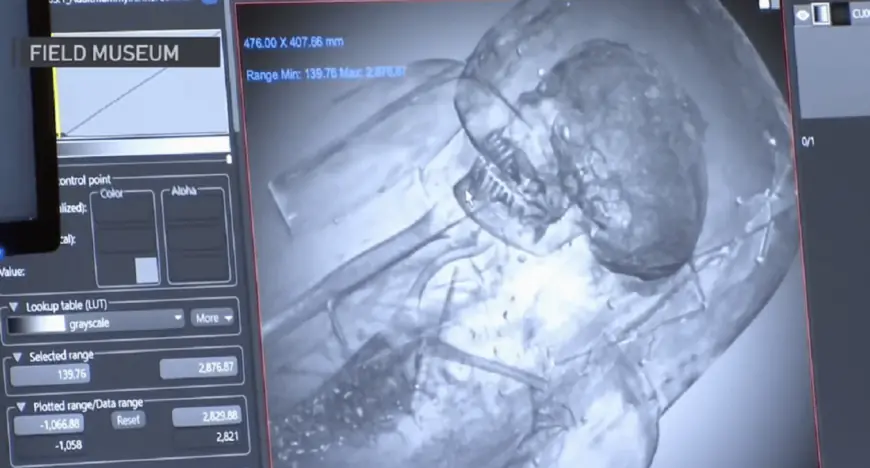New research at Field Museum peels back layers of the past for Egyptian remains
They have been dead for almost 3,000 years, but the mummified Egyptian remains at Chicago’s Field Museum all have a new set of CT Scans. The computed tomography is part of a larger effort to better understand the lives and deaths of ancient Egyptians, as well as the mortuary practices that resulted in their preservation. “Until very recently, CT scanning wasn’t available, so we have almost no information available on the soft tissue, the actual flesh, on the mummies,” said J.P. Brown, the museum’s senior conservator. Because the remains are large, heavy and fragile, the Field made use of a portable CT scanning trailer that was parked on the museum’s lot. In all, 26 individuals were scanned in a process that takes thousands of x-rays, then stacks the images to create a full, 3-D model of the remains and the container or coffin in which they are carried. Many of the remains were marked with names on the coffins, making it possible to know who they were in life. “As an archeologist, it’s extremely rare to see history from the standpoint of a single individual,” said Stacy Drake, the collections manager for biological anthropology. The scans also give researchers a better understanding of the mummification process. “One of the interesting things about the Egyptian mummification process is that we really don’t know how it works,” said Brown. He said people have tried to recreate the recipe in modern times with little success. One of the coffins the Field scanned was thought to be empty but turned out to have some remains inside. Others showed damage over the years. The scanning also shed a new light on some of the best-preserved examples in the museum’s collection like Lady Chenet-aa. She had supplementary eyes placed into her eye sockets to ensure they came with her into the afterlife. “All of this treatment suggests she was a person of some status; not the highest status, but enough status that she could afford these nice treatments,” Drake said. The CT scanning process will allow researchers to peel back the layers of these ancient Egyptians’ lives and better understand the society in which they lived. The research is expected to take more than a year. The scans themselves will be shared with other researchers around the world.

They have been dead for almost 3,000 years, but the mummified Egyptian remains at Chicago’s Field Museum all have a new set of CT Scans. The computed tomography is part of a larger effort to better understand the lives and deaths of ancient Egyptians, as well as the mortuary practices that resulted in their preservation.
“Until very recently, CT scanning wasn’t available, so we have almost no information available on the soft tissue, the actual flesh, on the mummies,” said J.P. Brown, the museum’s senior conservator.
Because the remains are large, heavy and fragile, the Field made use of a portable CT scanning trailer that was parked on the museum’s lot. In all, 26 individuals were scanned in a process that takes thousands of x-rays, then stacks the images to create a full, 3-D model of the remains and the container or coffin in which they are carried.
Many of the remains were marked with names on the coffins, making it possible to know who they were in life.
“As an archeologist, it’s extremely rare to see history from the standpoint of a single individual,” said Stacy Drake, the collections manager for biological anthropology.
The scans also give researchers a better understanding of the mummification process.
“One of the interesting things about the Egyptian mummification process is that we really don’t know how it works,” said Brown. He said people have tried to recreate the recipe in modern times with little success.
One of the coffins the Field scanned was thought to be empty but turned out to have some remains inside. Others showed damage over the years.
The scanning also shed a new light on some of the best-preserved examples in the museum’s collection like Lady Chenet-aa. She had supplementary eyes placed into her eye sockets to ensure they came with her into the afterlife.
“All of this treatment suggests she was a person of some status; not the highest status, but enough status that she could afford these nice treatments,” Drake said.
The CT scanning process will allow researchers to peel back the layers of these ancient Egyptians’ lives and better understand the society in which they lived. The research is expected to take more than a year. The scans themselves will be shared with other researchers around the world.
What's Your Reaction?








































































































